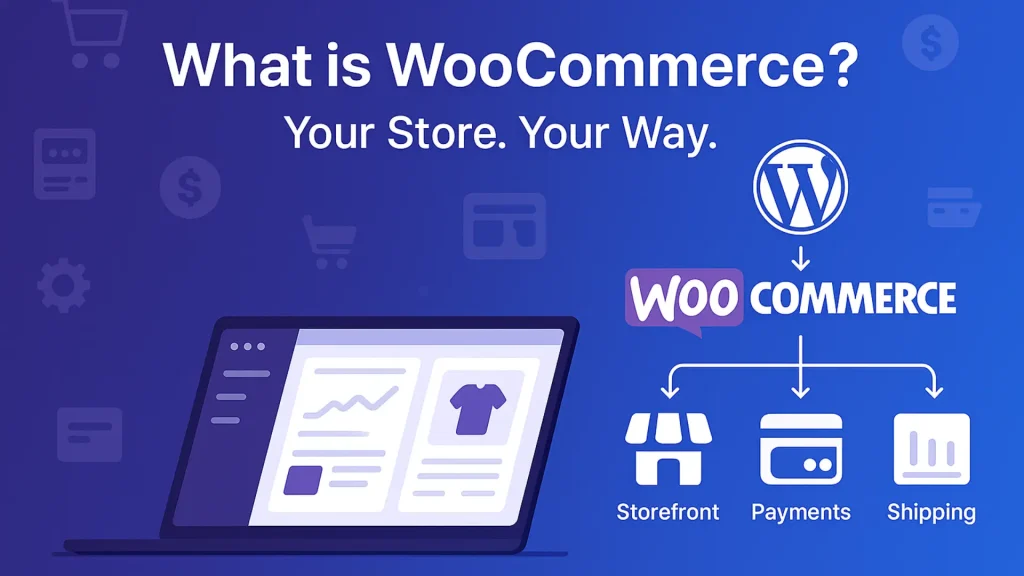E-commerce is no longer just an option, it’s becoming the standard for businesses worldwide. In 2025, global e-commerce sales are projected to reach $4.32 trillion, marking an 8.37% increase from the previous year.
This growth isn’t confined to global markets. In fact, India’s e-commerce industry, valued at Rs. 10,82,875 crore (US$ 125 billion) in FY24, is expected to reach Rs. 29,88,735 crore (US$ 345 billion) by FY30, marking a 15% compound annual growth rate (CAGR) over the forecast period.
More people are shopping online now because it’s easier, faster, and more convenient. This change is happening mainly because smartphones and internet access have become cheaper and more common.
For businesses in India, keeping up with this change is really important. Whether you’re starting a new business, running a shop, or just looking for ways to grow online, it’s helpful to know what tools are available to sell your products on the internet.
In this blog, we’ll explore WooCommerce, a platform that enables businesses to set up and manage online stores. We’ll discuss what is WooCommerce, how it works, and compare it to other platforms. By the end, you’ll have a clearer picture of whether WooCommerce aligns with your business goals and how it can support your journey into e-commerce.
What is WooCommerce?
WooCommerce is a free plugin designed to transform a standard WordPress website into a fully functional online store. It offers a user-friendly interface, allowing individuals and businesses to sell products or services directly from their websites without requiring extensive technical knowledge.
As of 2025, WooCommerce powers over 4.6 million live online stores globally, making it one of the most widely used e-commerce solutions. Its integration with WordPress, which itself powers approximately 43% of all websites on the internet, provides users with a familiar and flexible platform for managing their online presence.
The plugin supports a vast ecosystem of themes and extensions, enabling users to customize their stores to fit specific needs. Whether it’s adding payment gateways, managing inventory, or optimizing for search engines, WooCommerce offers tools to facilitate these tasks.
WooCommerce serves as a practical solution for those looking to enter the e-commerce space, offering scalability and customization within the WordPress environment.
What is WooCommerce Used For?
At its core, WooCommerce helps people sell online through their WordPress websites. It’s built to support a wide range of e-commerce needs, from simple product listings to complex transactions. Whether you’re just starting or managing a growing store, it adapts to different selling models.
Here’s a closer look at what people actually use WooCommerce for:
- Selling physical products
Clothing, electronics, books, and other tangible items can be listed with photos, prices, and shipping options. - Selling digital goods
Users can offer ebooks, music, software, or courses. File downloads are managed automatically after purchase. - Offering subscriptions or memberships
With the right extensions, WooCommerce supports recurring billing for ongoing access to services or premium content. - Creating a product catalog
Some businesses use WooCommerce to display products without activating online checkout, useful for inquiries or wholesale listings. - Enabling online checkout
Customers can add items to a cart, choose delivery preferences, and pay using multiple payment methods, including credit cards, wallets, and direct transfers. - Managing taxes and shipping
Built-in tools handle tax calculations based on customer location and allow detailed shipping setups, including local and international delivery rates. - Handling inventory and orders
Store owners can track stock levels, manage returns, and keep customers updated with automated order emails.
WooCommerce remains a practical choice for businesses that want control over their e-commerce setup, using tools that can scale as their store grows.
Is WooCommerce Free or Paid?
Yes, the core WooCommerce plugin is free to download and use. This is one of the reasons it’s become so popular among small business owners, startups, and independent sellers. You can start building your store without paying for the software itself.
That said, running a fully functional store may involve additional costs depending on your needs.
Here’s what to expect:
- Core features
You can add products, accept payments, manage orders, and customize your store design using only the free version of WooCommerce. - Hosting
Since WooCommerce runs on WordPress, you’ll need a web hosting plan. Basic shared hosting can be inexpensive, but growing stores often move to managed hosting for better speed and security. - Premium themes
While free themes are available, many store owners choose paid themes for a better layout, mobile responsiveness, or built-in design options. - Paid extensions and plugins
Extensions help you add specific functions like booking systems, advanced shipping rules, or marketing tools. Some are free, but many premium plugins charge a one-time fee or annual subscription. - Payment gateway fees
The plugin itself supports popular payment gateways, but the providers may charge transaction fees. This depends on your region and the service you choose.
WooCommerce is free, but building a complete store might involve investing in plugins, hosting, and design tools. The benefit is that you can scale and spend based on your actual business needs.
WooCommerce Pricing: What to Expect?
Running a store with WooCommerce offers flexibility in cost. The plugin itself is free, but other components like hosting, themes, and plugins can affect your budget. Here’s what to consider when planning the cost of running a WooCommerce store.
Each element comes with a wide pricing range, allowing you to scale based on your business size and technical needs.
Estimated Pricing Breakdown
Feature | Price Range (Yearly/One-Time) | Notes |
Domain name | $10 – $15/year | Common cost for .com or regional domains |
Hosting | $25 – $150/year | Shared hosting for starters, managed plans for performance |
WooCommerce core | Free | No charge to install and use |
Premium themes | $30 – $100 (one-time) | Optional for better design, responsiveness, and support |
Paid plugins/extensions | $25 – $150+ per plugin/year | Depends on features like bookings, subscriptions, marketing, etc. |
Store setup (DIY) | Free – $125+ (one-time) | Based on whether you hire help or use free resources |
Payment gateway fees | Varies | Typically 2% to 3% per transaction (Stripe, PayPal, Razorpay, etc.) |
SSL Certificate | Free – $100/year | Often included with good hosting providers |
Maintenance & updates | Optional | Costs depend on whether done in-house or by professionals |
Pricing references were gathered using:
- WooCommerce.com Extensions
- Popular hosting platforms like Bluehost, Godaddy, SiteGround, and managed WooCommerce hosting providers
The total WooCommerce pricing can range from very low to moderate, depending on your setup. For basic stores, a few essential plugins and reliable hosting are often enough to get started.
Is WooCommerce Safe to Use?
Yes, WooCommerce is built with security in mind. It runs on WordPress, which powers millions of websites worldwide, and benefits from the same regular updates, community oversight, and plugin security support. While no system is invincible, WooCommerce offers a solid foundation for running a secure online store when managed correctly.
Here’s what contributes to its safety:
- Regular updates
The WooCommerce development team consistently releases updates to patch vulnerabilities, improve performance, and maintain compatibility with the latest WordPress versions. - WordPress security features
Since WooCommerce is a WordPress plugin, it inherits all platform-level protections. This includes permission settings, user roles, and community-tested hardening guides. - SSL support
WooCommerce supports SSL certificates, which encrypt customer data and make checkout more secure. Most reputable hosting providers now include free SSL certificates as standard. - Secure payment gateways
Popular payment services like Stripe, PayPal, and Razorpay are integrated with WooCommerce. These gateways handle sensitive payment data separately and follow PCI compliance standards. - Active community and support
With a vast user base and development community, potential issues are usually identified and fixed quickly. There are also dedicated support channels and forums to report problems or seek help. - Third-party security plugins
You can add extra protection using security plugins that scan for threats, limit login attempts, and monitor for malware.
WooCommerce is safe, but its security also depends on how well the store is managed. Regular updates, strong passwords, trusted plugins, and secure hosting are essential for keeping things protected.
Is WooCommerce Good for SEO?
Yes, WooCommerce is considered an SEO-friendly platform because it builds on WordPress, which is known for offering strong on-page optimization capabilities. It allows users to fine-tune content, structure, and metadata, giving store owners the control needed to improve search visibility without complex setups.
Here are the reasons why it works well for SEO:
- Support for SEO plugins
WooCommerce works seamlessly with leading SEO tools like Yoast SEO, Rank Math, and All in One SEO. These plugins help manage titles, meta descriptions, XML sitemaps, and schema markup without needing technical skills. - Clean URLs and permalinks
It allows custom URL structures, which means product and category pages can be optimized for both users and search engines. - Optimized product pages
Each product listing can include unique descriptions, titles, images, alt text, and structured data. These elements support better ranking on image search and product-rich results. - Mobile readiness
Most WooCommerce themes are responsive by default. This ensures that the store performs well on mobile devices, which is essential as search engines prioritize mobile usability. - Fast loading potential
With proper hosting and caching, WooCommerce stores can load quickly. Page speed is a known factor that influences rankings and user experience. - Customizable content
Store owners can easily add blog posts, landing pages, or promotional pages within the same system. This supports content-driven SEO strategies that increase organic traffic.
If you’re unsure how optimization impacts online growth, our guide on what is SEO breaks down the basics and explains how it connects to long-term success.
Social Exposure supports businesses looking to improve online visibility through smart development choices, content planning, and proven strategies. With deep experience in WordPress and performance-focused setup, our SEO Services are built to help brands grow sustainably in a competitive space.
Is WooCommerce and WordPress the Same?
No, they are not the same, but they work together closely. WooCommerce is a plugin that adds e-commerce features to a WordPress website. On its own, WordPress is a content management system used for building and managing websites. When you install WooCommerce, it extends that system, turning your regular site into a working online store.
Here’s how the relationship works:
- WordPress is the foundation
It handles the layout, pages, posts, media, and all other site content. - WooCommerce runs on WordPress
You need an existing WordPress installation to use it. Once added, WooCommerce gives you tools to list products, take payments, and manage orders. - Both follow open-source structure
This allows for full control, custom themes, and plugins. Updates and support come from their large global communities.
So when people ask, is WooCommerce and WordPress the same, the answer is simple: WordPress is the platform, and WooCommerce is the plugin that brings e-commerce to it.
WooCommerce vs Other Platforms (Quick Comparison)
Choosing a platform depends on how much flexibility and control you want. Here’s a quick side-by-side comparison of WooCommerce with other popular e-commerce options. The key areas covered are customization, hosting, and cost structure.
Platform | Control | Customization | Pricing | Hosting Requirement |
WooCommerce | Full ownership | High with plugins | Free core, paid add-ons | Self-hosted |
Shopify | Limited to plans | Limited to their apps | Monthly plans + app charges | Hosted by Shopify |
BigCommerce | Moderate control | Fewer customization | Tiered pricing plans | Hosted by BigCommerce |
SureCart | Basic control | Growing ecosystem | Free plan available | WordPress required |
Ecwid | Easy setup | Basic store design | Free basic plan, premium tiers | Can be embedded |
Adobe Commerce | Enterprise-grade | Advanced customization | Expensive for small businesses | Self-hosted or Adobe |
Who Should Use WooCommerce?
WooCommerce is a good choice for anyone looking for a flexible ecommerce store setup that can grow over time. It’s built for those who want full control over their online business and the freedom to shape it based on specific needs.
Here’s who benefits most:
- Small business owners
They can start with minimal cost and scale gradually without changing platforms. - D2C brands
It allows direct control over product listings, marketing, and customer experience without relying on marketplaces. - Startups
With low initial costs and room to grow, it works well for testing and launching new ideas. - Students
Ideal for those learning ecommerce, digital marketing, or web development with real-world tools. - Developers
Open-source code and access to the WordPress ecosystem make it suitable for building custom solutions.
Whether you’re a startup or a growing company, Social Exposure helps you set up WooCommerce the right way, combining thoughtful development, clean structure, and long-term performance focus.
Conclusion
WooCommerce stands out as a practical choice for anyone planning to sell online through WordPress. It combines flexibility, full control, and an open-source foundation that grows with your business. Whether you’re managing physical products, digital downloads, or subscriptions, it offers tools that adapt to different selling needs without locking you into a rigid system.
From setup to scale, WooCommerce is a powerful way to build your store with flexibility and control, while staying connected to a platform you already know.
If you’re ready to launch or improve your online store, Social Exposure, a top-notch Website Development Company, helps you get started with smart implementation, clean design, and everything you need to go live with confidence.
Frequently Asked Questions
Is WooCommerce really free to use?
Yes, WooCommerce is free to install and use. However, depending on your needs, you might invest in paid plugins, premium themes, or hosting services to improve performance.
Can I use WooCommerce without technical skills?
Yes, it’s designed for non-technical users. The setup process is guided, and most functions can be managed from a simple dashboard.
Does WooCommerce work with all WordPress themes?
It works with most themes, but using a theme built specifically for WooCommerce ensures better layout, speed, and compatibility.
Is WooCommerce scalable for large stores?
Yes, it can handle large product catalogs and high traffic if hosted on the right infrastructure and optimized correctly.
How does WooCommerce handle taxes and shipping?
It includes tools for automatic tax calculations and flexible shipping setups, including zones, methods, and rates.
Do I need a business license to use WooCommerce?
WooCommerce doesn’t require a license to operate. However, local business regulations may require you to register depending on your region.
What payment gateways work with WooCommerce?
It supports a wide range including Stripe, PayPal, Razorpay, and direct bank transfers. These can be added easily through extensions.
Is WooCommerce beginner-friendly?
Yes, the interface is intuitive. For those who want help getting started, Social Exposure offers support with setup, product integration, and technical guidance.
Can I use WooCommerce in India?
Yes, it works well for Indian sellers and supports payment methods like UPI and local shipping partners through compatible plugins.
Does WooCommerce support mobile shopping?
Most WooCommerce themes are responsive, allowing customers to browse and purchase directly from their smartphones or tablets.






